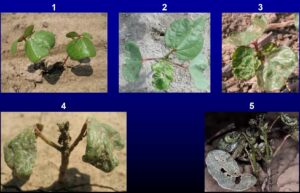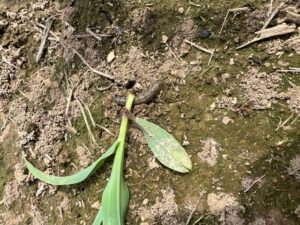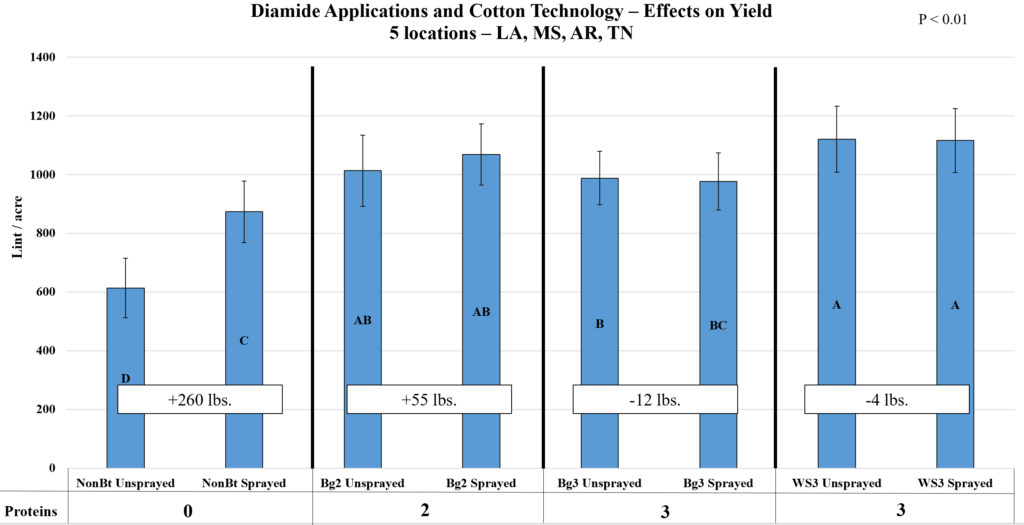The UT Cotton Scout School is scheduled for Tuesday, May 21st, at the West Tennessee Research and Education Center (605 Airways Blvd, Jackson). There is no fee, and preregistration is not required. Registration begins at 8:00 AM with the program starting at 8:30. Pesticide points in categories 1, 4, 10 and 12 will be offered and a BBQ lunch will be provided. Content will include classroom and hands-on training with an optional go-to-the-field session after lunch. Topics covered will include cotton development and identification and symptoms of insect pests, plant diseases, and weeds.
Category Archives: Insects
Early Season Thrips Considerations in Cotton
With warm conditions moving into West TN, many producers are underway with cotton planting. Below are a few things to consider with regards to thrips control.
ThryvOn: ThryvOn is Bayer’s Bt technology that has activity on thrips and plant bugs. ThryvOn cotton varieties are very effective against thrips and it is not anticipated that any fields will need foliar treatments. ThryvOn will still have thrips present (adults and immatures) but insecticide applications should not be triggered on thrips numbers but damage level (Fig 1.). Applications should be initiated when plant damage is approaching 3 in figure 1. That being said, I’ve evaluated ThryvOn varieties for several years under excellent and terrible growing conditions and I as well as my colleagues across the cotton belt, have never recommended a foliar spray for thrips.

Insecticide Seed Treatments (ISTs): ISTs are the predominate control method for thrips in cotton. IST performance can be highly variable depending on weather conditions and thrips pressure. High thrips pressure and poor growing conditions will often necessitate the use of foliar sprays even with ISTs. Seed treatment packages typically come in a base (storage rate of imidacloprid + fungicide) and field rates of imidacloprid (these have several names) + fungicides, others may have nematicides, biologicals etc. Base treated seed may as well have no insecticide, the small stored product rate will offer almost no control of insects in the field. Standard options of imidacloprid (0.375 mg ai/seed) are the minimum needed for insect control in field cotton.
In-furrow: In-furrow liquid applications of imidacloprid are more effective than seed treatments; however, resistance development to neonicotinoids are diminishing the efficacy of imidacloprid in-furrow. Fields with in-furrow imidacloprid may still require a foliar spray under heavy thrips pressure. Granular AgLogic (aldicarb 15G) is highly effective against thrips populations and works like aldicarb should.
Foliar Spray Options: My recommendations are going to be limited for foliar sprays. Based on ongoing tobacco thrips resistance monitoring, to organophosphates (OPs), started by Scott Stewart several years ago, I am hesitant to recommend Orthene or Bidrin for thrips sprays. Resistance levels, in assayed populations from West TN, and the number of complaint calls I received last year are a good indication that OPs have limited use against our tobacco thrips populations. There may be areas where OP’s worked last year but it’s hard to say if they will work this year. That being said, Intrepid Edge at 3.0 fl oz/a is my go to for foliar thrips control. Although more expensive than the OPs, Intrepid Edge runs no risk of flaring mites or aphids and a surfactant has shown to increase efficacy (herbicide surfactants will work if you’re co-applying). Recolonization vs failure is another subject with foliar sprays. Presence of adults doesn’t mean the application didn’t work, adult thrips are always present on seedling cotton. Presence of immature thrips means adults are feeding and laying eggs and whatever control method you used is broken.
I am big believer in NCSU’s thrips predictor model https://products.climate.ncsu.edu/ag/cottontip/. We utilize the model to target planting when thrips numbers are highest, growers would do the opposite. Model runs for locations around West TN show that cotton planted May 1st through the 15th have a low to medium probability of experiencing large thrips populations. This is hopefully a welcome relief from years of cold, wet springs with large thrips populations plaguing our cotton. The warm weather will help germinate cotton quicker and standard ISTs may be enough to push us to the 4 true leaf stage (when thrips are typically no longer a concern) without a foliar spray.
Cutworms in Seedling Corn
I’ve received a few calls in the past couple days on cutworms appearing in seedling corn. Below are some take home points on cutworms:

- You probably do not need to worry about cutworms if you have kept a weed free seed bed for 2-3 weeks prior to planting, and this is especially true if using some of the Bt corn technologies (see below). However, the weather this year has not generally allowed for burndown applications made 3-4 weeks before planting.
- Consider making an insecticide application near planting time. Relatively low rates of pyrethroid insecticides are typically effective for cutworm control. I do not recommend including an insecticide with herbicide applications that are made more than a couple weeks in advance of planting. Tank mixing an insecticide with an early burndown application may not be that effective. Cutworms you kill would have probably ‘cycled out’ before you planted. And because you cannot expect much residual control, there is the possibility of re-infestation between application and planting. The best time to make this application is within a few days before or after planting.
- Using Capture LFR or other in-furrow pyrethroid insecticide as an in-furrow spray can add some protection against insect pests not completely controlled by seed treatments (e.g., cutworms and sugarcane beetles). I would prefer a T-banded type application where some of the product is applied to the “shoulders” of the seed furrow. This should improve control of cutworms compared with an application where 100% of the product is applied in-furrow. However, in-furrow applications appear to provide adequate control of cutworms in most circumstances.
- No insecticide seed treatments should be expected to provide substantial control of cutworms. However, I have seen Poncho 1250 kill small cutworms in the past, don’t bet the farm on this though. Some Pioneer corn seed now includes a base treatment of Lumivia (chlorantraniliprole). This product should provide at least some control cutworm, but data is limited.
- Although Bt corn and cotton traits provide some protection against cutworms, planting into fields that are heavily infested can be risky. Bt corn traits such as Leptra, VT2 Pro, SmartStax, Viptera, ad nTrecepta corn can reduce cutworm injury. Vip corn (Leptra, Trecepta, Viptera) will provide the best protection from a Bt stand point. However, large larvae are much less susceptible to Bt toxins.
August 31 Bollworm/Budworm Catches for West TN
| Location | CEW | TBW |
| Hardeman (Bolivar) | 2 | 0 |
| Fayette (Whiteville) | 3 | 0 |
| Fayette (Somerville) | 12 | 0 |
| Shelby (Millington) | 4 | 0 |
| Tipton (Covington) | 3 | 0 |
| Tipton (North) | 3 | 0 |
| Lauderdale (Golddust) | 8 | 0 |
| Haywood(West) | 9 | 0 |
| Haywood (Brownsville) | 15 | 1 |
| Madison (WTREC) | 9 | 0 |
| Madison (North) | 0 | 0 |
| Crockett (Alamo) | 0 | 0 |
| Crockett (Friendship) | 2 | 0 |
| Dyer (King Rd) | 12 | 0 |
| Dyer (Dyersburg) | 1 | 0 |
| Lake (Ridgely) | 12 | 0 |
| Gibson (Trenton) | 30 | 0 |
| Gibson (Milan Rec) | 0 | 0 |
| Carroll (Coleman Farm) | 8 | 0 |
Numbers are consistently going down across West TN and this is the last week for trap catches.
Corn Earworms Showing Up in Soybeans
I’ve received a few calls this week on corn earworms (bollworm/podworm) showing up in fields across Tennessee. UT’s threshold for earworms, in beans, is based on sweep net sampling, crop value and control costs. The table below outlines the threshold based on the above factors.

Crop value is on the left-hand side, control costs are the 3rd row from the top and numbers beneath control costs are earworm numbers per 25 sweeps. The spot price of beans for (8/31) is $13.75 and control costs can vary from $10 to $16, depending on product choice, so the threshold in 25 sweeps would be 5 to 6 earworms per 25 sweeps. As crop price and control cost changes so does the number of earworms in our threshold.
Moths are typically attracted to later planted, more open canopy fields. However, earworms can be found in any stage beans. Insecticide choice depends on a few factors. If earworms are at or near threshold, acephate (0.75 lb/a) plus a pyrethroid is a cheaper option that provides acceptable control. This option runs the risk of flaring other pests (loopers, mites) and fields need to be rechecked 4-5 days after application to makes sure adequate control was achieved. If worms are above threshold safer choices would be Vantacor (1.2 fl oz), Elevest (5.0 fl oz), Besiege (7.0 fl oz), Intrepid Edge (4.0 fl oz) or Blackhawk (2.0 oz). The diamides (Vantacor, Besiege, Elevest) will have the longest residual control but many earworm issues in TN beans are solved after one application.
Another, more nonconvention option is Heligen (1.0 – 1.5 fl oz). Heligen is earworm specific and doesn’t have a fit on every acre. Applications should be initiated on small larvae at half a threshold (typically 2 – 4 larvae in 25 sweeps). Heligen is a virus that spreads throughout the field via infected larvae and requires some patience and knowledge of infection symptomology.
One final note, this product should almost be looked at as a preventative not a curative product. However, worms have to be in the field for the virus to infect the target and replicate causing an epizootic. Large populations of earworms, at or above threshold, need a conventional insecticide.
August 24 Bollworm/Budworm Catches for West TN
| Location | CEW | TBW |
| Hardeman (Bolivar) | 19 | 0 |
| Fayette (Whiteville) | 23 | 0 |
| Fayette (Somerville) | 24 | 2 |
| Shelby (Millington) | 20 | 0 |
| Tipton (Covington) | 2 | 1 |
| Tipton (North) | 11 | 0 |
| Lauderdale (Golddust) | 32 | 0 |
| Haywood(West) | 18 | 0 |
| Haywood (Brownsville) | 33 | 0 |
| Madison (WTREC) | 33 | 0 |
| Madison (North) | 18 | 0 |
| Crockett (Alamo) | 0 | 1 |
| Crockett (Friendship) | 26 | 0 |
| Dyer (King Rd) | 28 | 0 |
| Dyer (Dyersburg) | 33 | 0 |
| Lake (Ridgely) | 39 | 0 |
| Gibson (Trenton) | 86 | 0 |
| Gibson (Milan Rec) | 1 | 0 |
| Carroll (Coleman Farm) | 17 | 0 |
Bollworm Egg Lay Increasing in Cotton
Bollworm egg lay across West TN is rapidly increasing. Our trap catches across the survey area are steadily increasing and I’ve started receiving several calls about large numbers of eggs . Fortunately, the vast majority of our cotton is Widestrike 3 (WS3) or Bollgard 3 (BG3). To date, I’ve had no reports of slippage through any three gene cotton in Tennessee. Going forward, our threshold for foliar applications targeting bollworms occurs when a combination of square and boll sampling shows 6 percent or more injury (e.g., 3 percent square injury and 3 percent boll injury, 4 percent square injury and 2 percent boll injury, etc.) and/or 4 or more larvae are present per 100 plants. Treatments based on egg lay is not recommended in 3 gene cottons. My colleague at Mississippi State, Dr. Tyler Towles, summarized our regional data (Fig. 1) demonstrating no economic benefit to making a diamide application to 3 gene cottons. Unless you’re at threshold, save the money on the diamide spray in 3 gene cotton.
One final note, as we are nearing the end of the 2023 growing season below are insect termination timings based on DD60s.
- Tarnished Plant Bugs: NAWF 5 + 300 DD60s
- Bollworms: NAWF 5 + 350-400 DD60s
- Spider Mites: NAWF 5 + 350 DD60s
- Stinkbugs: NAWF 5 + 400-450 DD60s
- Fall Armyworms: NAWF 5 + 400-450 DD60s

August 17 Bollworm/Budworm Catches for West TN
| Location | CEW | TBW |
| Hardeman (Bolivar) | 6 | 0 |
| Fayette (Whiteville) | 29 | 0 |
| Fayette (Somerville) | 26 | 0 |
| Shelby (Millington) | 42 | 0 |
| Tipton (Covington) | 2 | 0 |
| Tipton (North) | 20 | 0 |
| Lauderdale (Golddust) | 35 | 0 |
| Haywood(West) | 8 | 1 |
| Haywood (Brownsville) | 67 | 0 |
| Madison (WTREC) | 41 | 1 |
| Madison (North) | 35 | 0 |
| Crockett (Alamo) | 1 | 1 |
| Crockett (Friendship) | 51 | 0 |
| Dyer (King Rd) | 48 | 1 |
| Dyer (Dyersburg) | 61 | 0 |
| Lake (Ridgely) | 35 | 2 |
| Gibson (Trenton) | 98 | 0 |
| Gibson (Milan Rec) | 4 | 0 |
| Carroll (Coleman Farm) | 15 | 2 |

